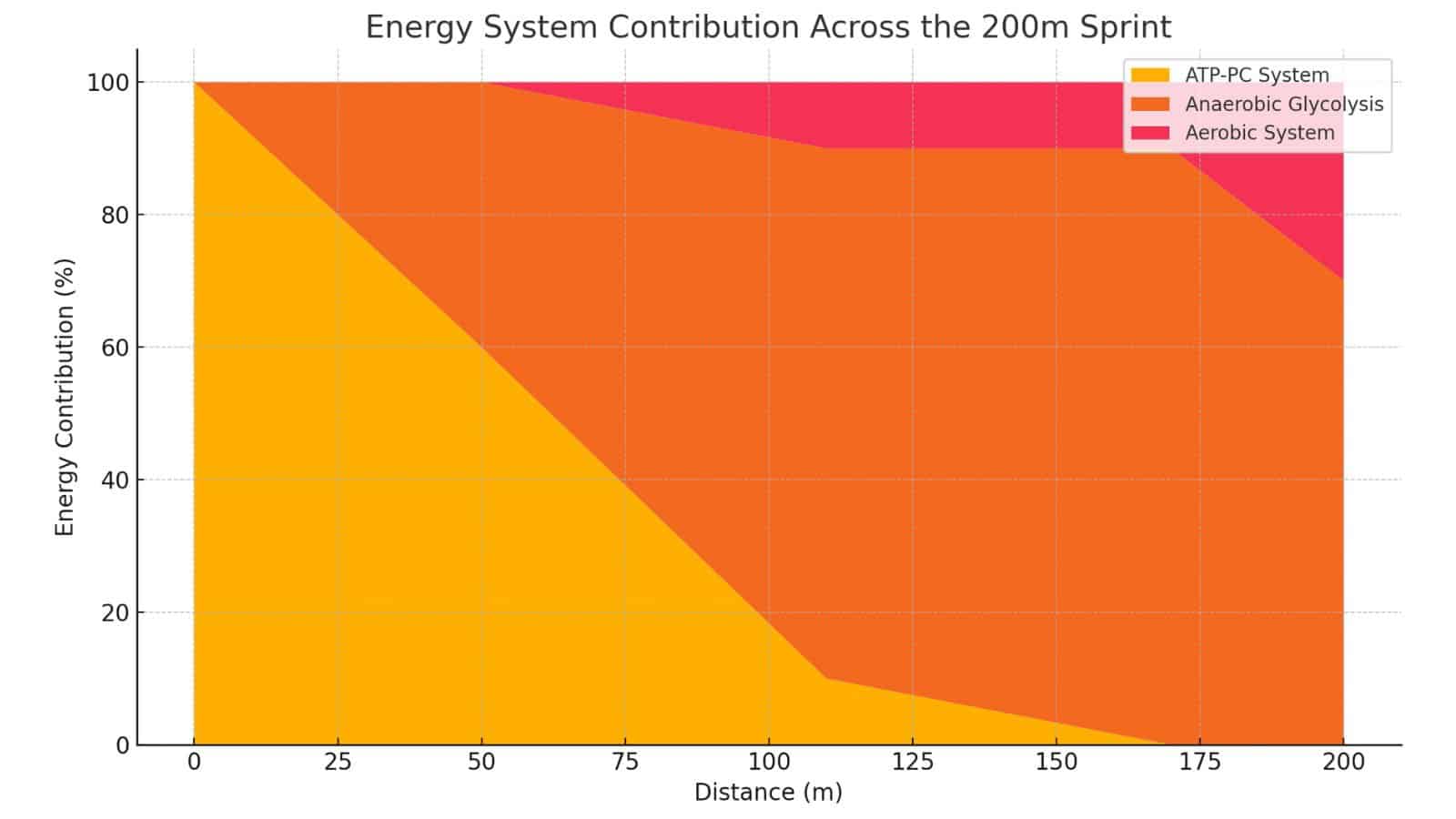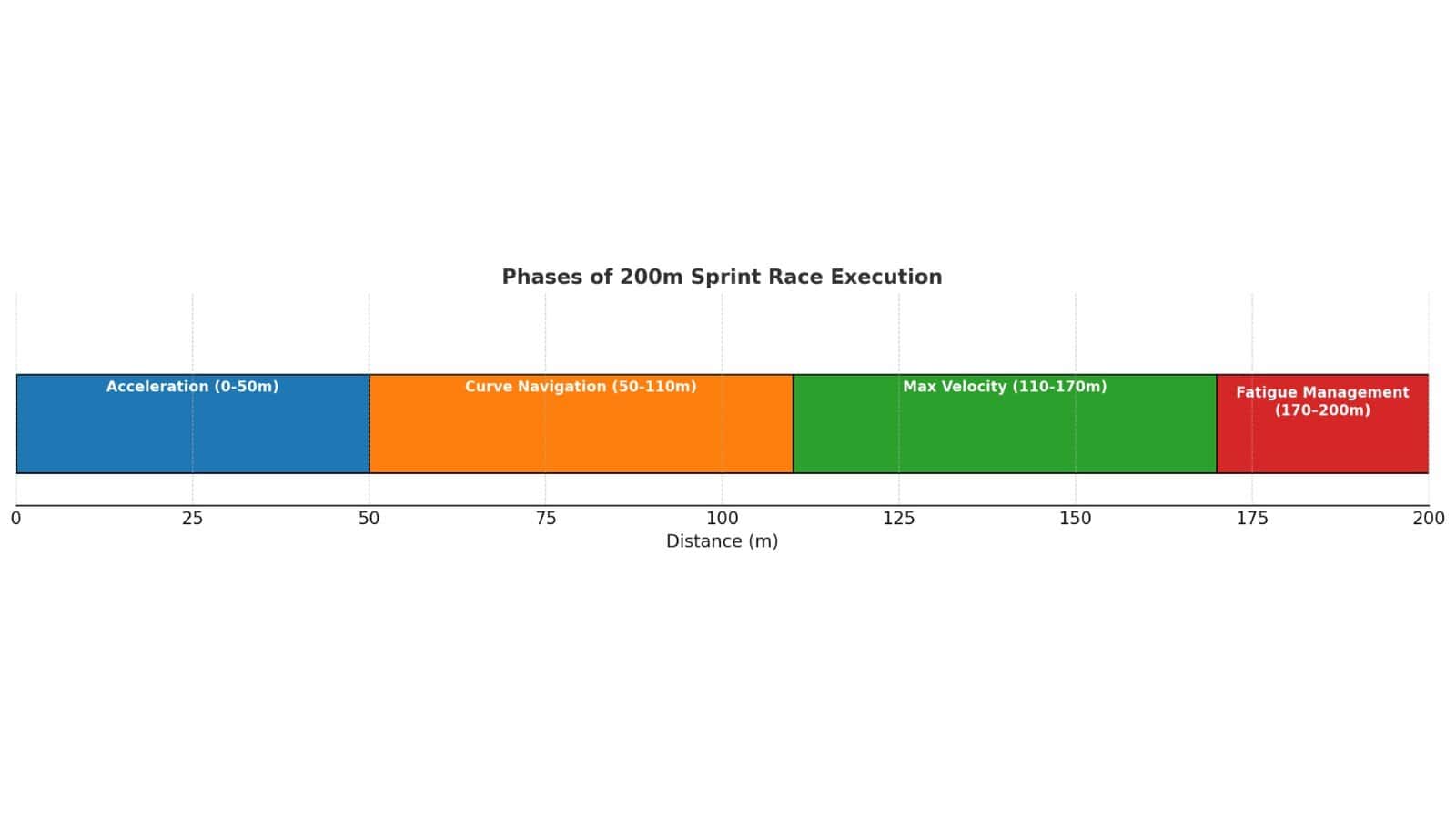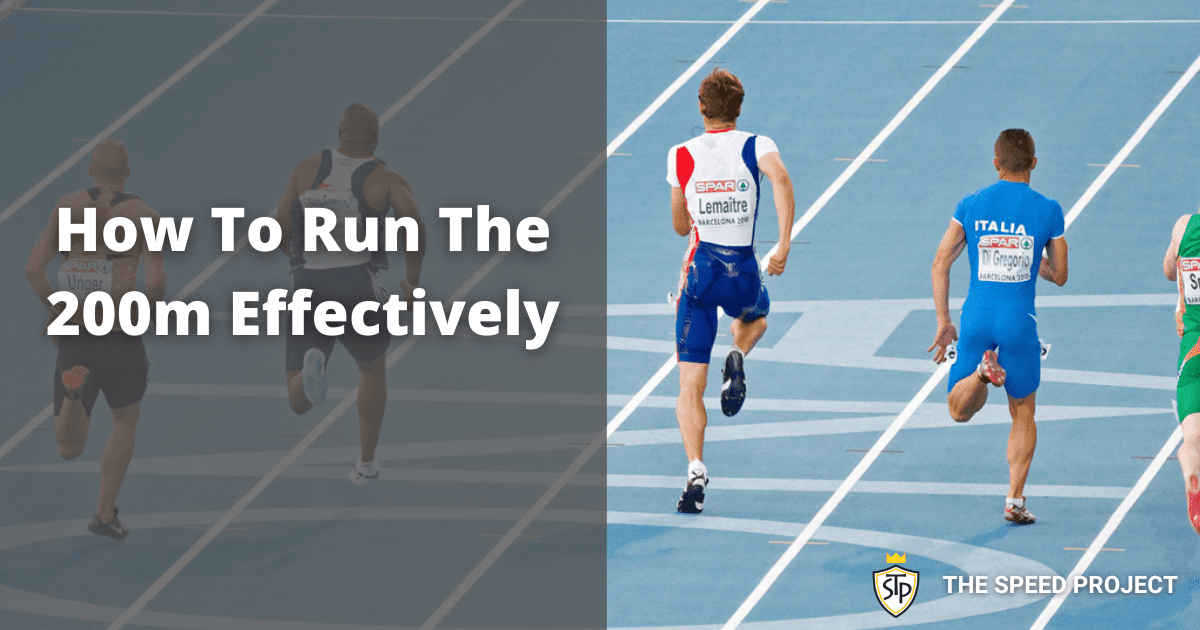The 200m sprint represents the ultimate test of speed and power endurance, demanding precise biomechanical execution across distinct physiological phases.
Elite sprinters achieve winning times through sophisticated energy system management while navigating the complex biomechanical challenges of curve running at maximum velocity.
Successful 200m performance requires optimal coordination between anaerobic alactic and lactic energy systems, with the anaerobic lactic system contributing significantly to total energy production.
This unique physiological demand, combined with asymmetrical force production during curve running, creates specific training and technical requirements that separate elite performers from recreational sprinters.
This comprehensive guide examines strategies for maximizing 200m performance through proven training methodologies, biomechanical optimization, and race execution protocols that elite athletes use to achieve sub-20-second performances.
Access our free guide on how to structure a year of training when you sign up!
The 200m Formula: Controlled acceleration + curve mastery + energy management = faster times
4 Race Phases:
- 0-50m: Build speed gradually, don’t go all-out
- 50-110m: Rotate hips through curve, stay upright
- 110-170m: Hit peak speed, then maintain it
- 170-200m: Pump arms hard when legs get heavy
Curve Technique: Don’t lean in – rotate your hips like “headlights following the road”
Training Weekly: 2-3 speed sessions, 2-3 technique sessions, 3-4 support work
Pacing: First 100m should be 1-2% faster than second 100m
Biggest Mistakes: Starting too fast, leaning in curves, ignoring arm action when tired
The Biomechanical Foundation of 200m Sprint Performance
Energy System Coordination and Performance Phases
The 200m sprint utilizes three distinct energy systems across four identifiable phases, each requiring specific biomechanical and metabolic adaptations.

Understanding these phases enables coaches and athletes to develop targeted training protocols that optimize performance across the entire race distance.
Phase 1: ATP-PC Dominance (0-50m)
During the initial acceleration phase, the phosphocreatine system provides immediate energy for explosive force production. Elite sprinters generate substantial ground reaction forces during this phase, requiring optimal neuromuscular coordination and mechanical positioning.
Phase 2: Energy System Transition (50-110m)
The critical transition from ATP-PC to anaerobic glycolysis occurs while navigating the curve. This phase demands technical precision in managing centripetal force requirements while maintaining high-velocity output as lactate accumulation begins.
Phase 3: Lactate Management (110-170m)
Maximum velocity maintenance occurs as anaerobic lactic system contribution peaks. Elite athletes demonstrate superior lactate buffering capacity and mechanical efficiency to sustain speed through increasing metabolic stress.
Phase 4: Neuromuscular Preservation (170-200m)
Performance degradation management becomes critical as lactate accumulation affects muscle contraction quality. Maintaining biomechanical integrity prevents the exponential speed loss that characterizes recreational sprinters.
Curve Running Biomechanics and Centripetal Force Management
Curve running creates significant biomechanical asymmetries between inside and outside legs, with the outside leg experiencing substantially higher impact forces compared to straight-line sprinting. Understanding these demands enables targeted preparation for the unique stresses of 200m competition.
Centripetal Force Requirements
The physics equation Fc = mv²/r demonstrates how increased velocity and tighter curve radius exponentially increase centripetal force demands. Elite sprinters running at high speeds through a standard 200m curve must generate substantial lateral force per step while maintaining forward propulsion.
Body Position and Lean Angle Optimization
Contrary to popular coaching cues about “leaning into the turn,” optimal curve running appears to involve coordinated hip positioning rather than lateral body lean.
The most effective technique involves rotating the pelvis to align with the lane angle while maintaining vertical torso alignment, similar to “headlights following the road.”
Asymmetrical Loading Patterns
The outside leg contributes primarily to forward propulsion while the inside leg generates increased lateral force production. This creates training implications for developing unilateral strength and coordination patterns specific to curve running demands.
| Variable | Inside Leg | Outside Leg |
|---|---|---|
| Primary Function | Lateral force generation | Forward propulsion |
| Force Direction | Inward (toward curve center) | Forward |
| Ground Contact Time | Slightly longer | Slightly shorter |
| Injury Risk Focus | Hip and knee stress | Hamstring and ankle overload |
| Training Implication | Unilateral coordination and stability | Power output and propulsion mechanics |
Evidence-Based Race Execution Strategy

Phase 1: Explosive Acceleration (0-50m)
Block Setup and Starting Mechanics
Optimal block positioning varies based on individual biomechanics, but maintaining consistent setup reduces performance variability. Elite sprinters typically demonstrate high consistency in block spacing and angle across competitions.
Starting technique focuses on maximum force application through the first 10 meters, with gradual velocity development through 30-40 meters.
The key distinction from 100m sprinting involves controlled acceleration that preserves energy for later race phases while establishing optimal lane position for curve entry.
Ground Contact Optimization
During this phase, focus on driving each foot forcefully into the track surface with relatively brief contact times. The driving position should extend through approximately 30 meters, with gradual transition to upright sprinting mechanics beginning around the 40-meter mark.
Technical Execution
- First 10 meters: Maximum power output with explosive acceleration drive
- 10-30 meters: Gradual force increase while maintaining driving position
- 30-50 meters: Transition to upright position while approaching curve entry
Phase 2: Curve Navigation and Velocity Development (50-110m)
Hip Positioning and Directional Control
Elite technique involves precise hip rotation to align with lane curvature while maintaining vertical torso positioning. This “headlight technique” allows natural centripetal force generation without compromising forward momentum or creating excessive lateral lean.
Arm Action Modification
The right arm crossing the body midline during left curve running may assist in generating necessary rotational momentum. This technique helps maintain balance while allowing the outside leg to effectively drive forward propulsion.
Velocity Management Through Curve Phases
The curve divides into two distinct biomechanical phases:
Uphill Phase (50-80m): Continue building toward maximum velocity while establishing curve running mechanics. This requires increased force production to maintain acceleration against increasing centripetal force demands.
Downhill Phase (80-110m): Utilize the natural momentum from curve physics to achieve peak velocity. Elite sprinters often report a “slingshot effect” where proper positioning allows the track geometry to assist acceleration.
Phase 3: Maximum Velocity Maintenance (110-170m)
Stride Mechanics and Ground Contact
Peak velocity typically occurs during the first 20 meters of the straightaway as athletes benefit from the momentum generated through optimal curve execution. Ground contact should occur directly beneath the center of mass with minimal contact times.
Biomechanical Efficiency Focus
Maintain optimal stride length without overstriding, which creates braking forces that reduce velocity. Elite sprinters demonstrate consistent stride frequency during this phase while preserving mechanical efficiency under increasing lactate stress.
Energy Distribution Strategy
This phase requires careful energy management as anaerobic lactic system contribution peaks. Focus on sustainable power output that allows completion of the final 30 meters without catastrophic speed loss.
Phase 4: Speed Preservation Under Fatigue (170-200m)
Neuromuscular Coordination Maintenance
As lactate accumulation affects muscle contraction quality, arm action becomes critical for maintaining leg turnover. Powerful arm drive can help compensate for declining leg power output during the final phase.
Technical Focus Points
- Maintain forward shoulder position to direct energy horizontally
- Utilize “drum beating” arm action to sustain leg frequency
- Preserve stride length while accepting slight frequency reduction
- Avoid premature finishing lean until the final 2 meters
Fatigue Management Strategies
Elite athletes demonstrate superior lactate buffering and neuromuscular coordination that allows sustained power output through the finish. Training these capabilities requires specific protocols that simulate race-pace lactate accumulation while maintaining technical precision.
Comprehensive Training Methodology for 200m Performance
Energy System Development Protocols
Anaerobic Alactic System Enhancement
Short-duration, maximum-intensity efforts with complete recovery develop the ATP-PC system capacity critical for race initiation and maximum velocity achievement.
Training Protocol Example:
- 6 x 30m block starts with 4-5 minutes recovery
- Focus: Maximum acceleration and technical precision
- Implementation: 2-3 sessions per week during speed development phases
Anaerobic Lactic System Optimization
Specific endurance work develops lactate production, buffering, and clearance capabilities essential for 200m performance. These sessions simulate race-pace physiological stress while maintaining technique under fatigue.
Training Protocol Example:
- 3 x 150m at 200m race pace with 8-10 minutes recovery
- Focus: Lactate tolerance and speed endurance
- Implementation: 1-2 sessions per week during competitive preparation
Speed Endurance Integration
Longer distance work at high intensities develops the energy system coordination and neuromuscular endurance required for maintaining velocity through increasing lactate accumulation.
Training Protocol Example:
- 300m + 200m + 100m with walk-back recovery between reps and 12 minutes between sets
- Focus: Energy system coordination and technical maintenance under stress
- Implementation: Weekly during specific preparation phases
Biomechanical Development Training
Curve Running Technique Development
Specific drills and exercises address the unique biomechanical demands of high-speed curve running while developing the asymmetrical strength patterns required for optimal performance.
Training Protocols:
- Curve running progressions: 6 x 80m curves at 90-95% intensity
- Asymmetrical strength training: Single-leg squats, lateral bounds, rotational core work
- Technical integration: 4 x 120m from curve start focusing on hip positioning
Acceleration Mechanics Optimization
Block start practice and acceleration development create the foundation for race execution while establishing optimal body positions for subsequent race phases.
Training Protocols:
- Block start consistency: 8 x 30m focusing on identical setup and execution
- Acceleration development: 5 x 50m with emphasis on gradual velocity building
- Transition work: 4 x 60m focusing on drive-to-upright phase timing
Neuromuscular Coordination Enhancement
Technical Integration Under Fatigue
Training protocols that combine technical precision with physiological stress develop the neuromuscular coordination required to maintain efficiency during competitive situations.
Training Protocol Example:
- 200m broken runs: 100m + 100m with 90 seconds recovery
- Focus: Technical maintenance during lactate accumulation
- Implementation: Bi-weekly during competitive season
Reactive Strength and Power Development
Plyometric and reactive strength training enhance the rapid force production capabilities essential for sprint performance while developing injury resilience.
Training Protocols:
- Depth jumps: 4 x 5 from 30cm height focusing on minimal ground contact
- Reactive bounds: 3 x 8 alternating leg bounds for distance
- Integration: Sprint-jump combinations linking power development to sprint mechanics
Periodization and Training Distribution
Annual Training Structure
General Preparation Phase (12-16 weeks)
Establish aerobic base, general strength, and movement competency that supports subsequent high-intensity training adaptations.
Specific Preparation Phase (8-12 weeks)
Develop event-specific energy systems, biomechanical patterns, and neuromuscular coordination through progressive intensity and specificity increases.
Competitive Phase (12-20 weeks)
Maintain developed capabilities while optimizing performance through technique refinement and strategic training load management.
Weekly Training Distribution
High-Intensity Sessions (2-3 per week)
Speed, speed endurance, and specific endurance work performed at or above race pace with appropriate recovery.
Technical Development (2-3 per week)
Acceleration, curve running, and biomechanical refinement sessions focusing on movement quality and consistency.
Supporting Elements (3-4 per week)
Strength training, mobility work, and recovery protocols that support adaptation and injury prevention.
Performance Testing and Monitoring Protocols
Biomechanical Assessment Methods
Video Analysis Protocols
Regular technical assessment using high-speed video analysis enables identification of mechanical inefficiencies and tracking of technical development over time.
Key Measurement Points:
- Block start consistency and force application angles
- Curve running hip position and lean angle measurements
- Stride frequency and length throughout race phases
- Arm action coordination and timing patterns
Physiological Monitoring
Lactate Testing Protocols
Structured lactate testing provides objective feedback about energy system development and training adaptation.
Testing Protocol:
- 300m time trial with immediate post-exercise lactate measurement
- Target values: Elite 200m sprinters typically show elevated lactate levels
- Implementation: Monthly during preparation phases
Speed and Power Assessment
Regular testing of fundamental speed and power capabilities enables tracking of training adaptations and identification of performance limiters.
Testing Battery:
- 30m block start (acceleration capability)
- Flying 30m (maximum velocity)
- Standing triple jump (reactive strength)
- 150m time trial (speed endurance)
Competition Preparation and Race Day Execution
Pre-Competition Preparation Protocols
Technical Rehearsal Sessions
Race-pace rehearsals under simulated competition conditions develop technical consistency and tactical confidence.
Rehearsal Protocol:
- Full 200m at 98-100% effort with complete warm-up and recovery protocols
- Focus on execution of race strategy and technical cues
- Implementation: 7-10 days before major competition
Physiological Preparation
Specific activation protocols prepare energy systems and neuromuscular function for optimal race performance.
Competition Day Warm-Up:
- 15-20 minutes progressive cardiovascular preparation
- Dynamic mobility and activation exercises
- 3-4 progressive accelerations building to race pace
- Technical rehearsal of curve running mechanics
- 2-3 practice starts focusing on consistency
Tactical Considerations and Lane Strategy
Lane Assignment Impact
Different lane assignments require adjusted tactical approaches based on curve radius and competitor positioning.
Inside Lanes (1-3): Tighter curve radius increases centripetal force demands but provides better awareness of competitor positioning. Focus on aggressive early pace to establish position before the curve.
Middle Lanes (4-6): Optimal curve radius allows for controlled pace development and strategic positioning. Implement standard race execution strategy with adjustments based on competitor responses.
Outside Lanes (7-8): Wider curve radius reduces centripetal force demands but limits competitor awareness. Focus on executing optimal race strategy regardless of competitor actions.
Performance Optimization Strategies
Energy Distribution Management
Successful 200m performance requires precise energy distribution across race phases to maximize finishing speed potential.
Pacing Strategy:
- First 100m: Typically 1-2% faster than second 100m split
- Curve execution: Maintain effort level while allowing track geometry to assist
- Straightaway: Gradual acceleration building to maximum sustainable velocity
- Final 30m: Technical focus on maintaining speed rather than additional acceleration
Mental Execution Framework
Develop race-specific mental cues that maintain technical focus under competitive stress while enabling optimal performance execution.
Mental Cue Progression:
- Start: “Explosive drive with patience”
- Curve: “Hip position and momentum flow”
- Straightaway: “Powerful arms drive powerful legs”
- Finish: “Technical precision through the line”
Advanced Performance Considerations
Individual Adaptation Strategies
Biomechanical Variation Management
Individual anthropometric and biomechanical differences require customized technical approaches while maintaining fundamental performance principles.
Training Modification Examples:
- Shorter athletes: Emphasis on stride frequency development and acceleration mechanics
- Taller athletes: Focus on stride length optimization and curve running technique
- 100m specialists: Enhanced speed endurance and lactate tolerance development
- 400m background: Maximum velocity development and neuromuscular power enhancement
Technology Integration for Performance Enhancement
Biomechanical Feedback Systems
Modern technology enables real-time feedback about technique execution and performance parameters during training sessions.
Implementation Options:
- GPS-based velocity tracking for pace management
- Force plate analysis for start and acceleration optimization
- High-speed video analysis for technical refinement
- Lactate monitoring for energy system development verification
Injury Prevention and Performance Sustainability
Load Management Protocols
The high-intensity demands of 200m training require careful load management to prevent overuse injuries while maintaining adaptation stimulus.
Monitoring Parameters:
- Weekly training impulse (intensity x volume)
- Subjective recovery ratings
- Biomechanical efficiency markers
- Performance consistency indicators
Asymmetrical Stress Management
The biomechanical asymmetries inherent in curve running create specific injury risks that require targeted prevention strategies.
Prevention Protocols:
- Unilateral strength training addressing left-right differences
- Rotational mobility work for spine and hip function
- Bilateral curve running practice (clockwise and counterclockwise)
- Regular manual therapy addressing asymmetrical adaptations
Integrating Science and Performance
Successful 200m sprint performance emerges from the sophisticated integration of biomechanical precision, physiological optimization, and tactical execution.
Elite athletes distinguish themselves through superior energy system coordination, technical consistency under fatigue, and strategic race management that maximizes their physiological capabilities.
The approach outlined in this guide provides coaches and athletes with specific protocols for developing the complex capabilities required for 200m excellence.
Implementation success depends on consistent application of these principles while adapting training methods to individual characteristics and competitive demands.
Key performance factors include optimal energy system development through specific training protocols, biomechanical mastery of curve running techniques, and tactical sophistication that enables strategic race execution.
Athletes who systematically develop these capabilities while maintaining technical precision under competitive stress achieve the consistency required for elite-level performance.
Regular assessment and modification of training approaches ensures continued adaptation and performance improvement.
The integration of modern technology and monitoring systems enhances the precision of training interventions while providing objective feedback about adaptation and performance development.
Success in the 200m sprint ultimately requires dedication to systematic development across multiple performance domains while maintaining unwavering focus on technical precision under physiological stress.
Athletes who achieve consistent sub-20-second performances demonstrate superior integration of speed, power endurance, and biomechanical efficiency that emerges from years of consistent training progression.
The pathway to elite 200m performance demands patience with the complex adaptation process while maintaining intensity in training execution.
Successful sprinters typically require several years of consistent specific preparation to fully develop the neuromuscular coordination and energy system capabilities necessary for optimal race execution.
Implementation of the protocols outlined in this guide should progress systematically, beginning with foundational movement quality and energy system development before advancing to race-specific intensities and technical complexities.
Athletes and coaches must resist the temptation to accelerate this progression, as premature advancement to high-intensity training without adequate preparation increases injury risk while limiting long-term performance potential.
The most successful 200m training programs demonstrate consistency in fundamental principles while adapting specific methods to individual characteristics and competitive demands. This requires ongoing assessment of training responses and performance development to ensure optimal adaptation stimulus without exceeding recovery capabilities.
Ultimately, excellence in the 200m sprint emerges from the disciplined application of proven principles combined with relentless attention to technical detail.
Athletes who commit to this comprehensive approach while maintaining perspective on long-term development create the foundation for sustained competitive success and personal best performances when it matters most.
The journey toward 200m mastery represents one of track and field’s most demanding challenges, requiring the perfect synthesis of raw speed, tactical intelligence, and technical precision.
Those who embrace this complexity while maintaining focus on systematic preparation position themselves for breakthrough performances that define athletic careers.

